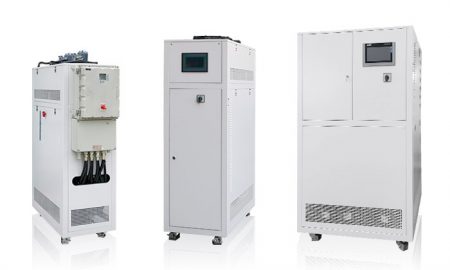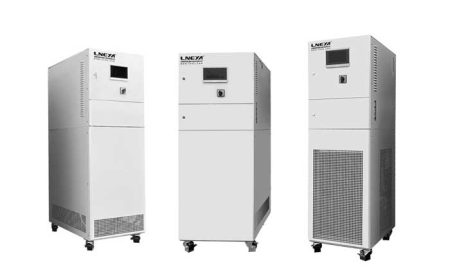Circulation Chiller
The refrigeration system components of circulation chiller
1. Compressor: This is the core component of the entire refrigeration system and the power source for refrigerant compression. Its function is to convert the input electrical energy into mechanical energy and compress the refrigerant.
2. Condenser: During the refrigeration process, the condenser plays the role of outputting heat energy and condensing refrigerant. After the high-pressure superheated steam discharged from the refrigeration compressor enters the condenser, all the heat absorbed during the working process, including the heat absorbed from the evaporator, refrigeration compressor and pipelines, is transferred to the surrounding medium (water or air) and taken away; The high-pressure superheated vapor of the refrigerant recondenses into a liquid. (According to different cooling media and cooling methods, condensers can be divided into three categories: water-cooled condensers, air-cooled condensers and evaporative condensers.)
3. Liquid reservoir: The liquid reservoir is installed behind the condenser and directly connected to the drain pipe of the condenser. The refrigerant liquid of the condenser should flow into the liquid reservoir unimpeded in order to make full use of the cooling area of the condenser. On the other hand, when the heat load of the evaporator changes, the demand for refrigerant liquid also changes. At this time, the liquid receiver plays the role of regulating and storing refrigerant. For small refrigeration plant systems, a condenser is often used to condition and store the refrigerant rather than installing a liquid reservoir.

4. Dry filter: In the refrigeration cycle of the circulating refrigerator, water and dirt (oil, iron filings, copper filings) must be prevented from entering. The main source of water is trace amounts of water contained in the newly added refrigerant and lubricating oil, or water brought by the air entering the maintenance system. If the water in the system is not completely discharged, when the refrigerant passes through the throttle valve (thermal expansion valve or capillary tube), sometimes the water will solidify into ice due to the drop in pressure and temperature, thereby blocking the channel and affecting the normal operation of the refrigeration device. Therefore, a filter drier must be installed in the refrigeration system.
5. Thermal expansion valve: The thermal expansion valve is not only a flow regulating valve in the refrigeration system, but also a throttle valve in the refrigeration equipment. It is installed between the dry filter and the evaporator of the refrigeration equipment, and its temperature sensing bag is wrapped at the outlet of the evaporator. Its main function is to reduce the pressure of high-pressure and normal-temperature refrigerant liquid when it flows through the thermal expansion valve, turning it into low-temperature and low-pressure refrigerant wet vapor (mostly liquid, a small part steam) into the evaporator, where it vaporizes And absorb heat to achieve the purpose of cooling.
6. Evaporator: The evaporator is a heat exchange device that relies on the evaporation (actually boiling) of the refrigerant liquid to absorb the heat of the cooling medium. Its function in a refrigeration system is to absorb heat (or output cooling capacity). In order to ensure that the evaporation process can be carried out stably and continuously, the evaporated gas must be continuously pumped away by the refrigeration compressor to maintain a certain evaporation pressure.
7. Refrigerant: Most industrial air coolers used in modern industry use R22 or R12 as refrigerant. Refrigerant is the working medium flowing in the refrigeration system. Its main function is to carry heat, absorbing and releasing heat when the state changes.
8. Water circulation system: The water circulation system of the circulating refrigerator is a water pump that leads water from the water tank to the equipment that the user needs to cool. The temperature of the chilled water rises after the heat is taken away by the chilled water, and then returns to the chilled water tank.
9. Electrical automatic control system: The electrical automatic control system includes the power supply part and the automatic control part. The power supply part supplies power to compressors, fans, water pumps, etc. through contactors. The automatic control part includes temperature controller, pressure protection, delay device, relay, overload protection and other functions, which can automatically start and stop according to the water temperature and protection.
Ofrecemos diseño y fabricación de sistemas completos de control de temperatura. Desde modelos estándar hasta productos personalizados completos. Nos especializamos en el servicio al cliente y nos dedicamos a ayudar a cada cliente a tener el sistema de control de temperatura óptimo para su necesidad específica.
Ofrecemos soluciones personalizadas no estándar. Disponemos tanto de enfriadoras individuales como de unidades combinadas de refrigeración y calefacción.
Correo electrónico: lilia@lneya.com WeChat ID: +8615251628237 WhatsApp: +86 17851209193


Enfriadoras de recirculación / Criotermostatos
El enfriador puede utilizarse ampliamente en diversas industrias y laboratorios, y admite diseños personalizados.
| Temperatura | Serie -25°C ~ +30°C | Serie -45°C ~ +30°C | Serie -60°C ~ -20°C | Serie -80°C ~ -20°C | Serie -120°C ~ -70°C | ||||
| Capacidad de refrigeración | 0,8 ~ 30 kW | 0,75 ~ 12 kW | 0,4 ~ 6kW | 0,2 ~ 6kW | 0,3 ~ 5kW | ||||
| Nota: Se puede personalizar cualquier rango de temperatura de -150℃ ~ +350℃ y cualquier capacidad de refrigeración. | |||||||||
 Mini refrigeradores / Refrigeradores pequeños
Mini refrigeradores / Refrigeradores pequeños
El enfriador puede utilizarse ampliamente en diversas industrias y laboratorios, y admite diseños personalizados.
| Temperatura | -18°C ~ +30°C | Serie +5°C ~ +35°C | |||||||
| Capacidad de refrigeración | 0,35 ~ 0,9 kW | 1,8 ~ 50 kW | |||||||
| Nota: Se puede personalizar cualquier rango de temperatura de -150℃ ~ +350℃ y cualquier capacidad de refrigeración. | |||||||||

Refrigeradores de baja temperatura
Estamos especializados en la producción de refrigeradores de baja temperatura con un rango de control de temperatura de hasta -150°C, que pueden satisfacer las necesidades de refrigeración de diferentes industrias.
| Temperatura | Serie -25°C ~ -5°C | Serie -45°C ~ -10°C | Serie -60°C ~ -10°C | Serie -80°C ~ -30°C | Serie -110°C ~ -50°C | Serie -150°C ~ -110°C | |||
| Capacidad de refrigeración | 12 ~ 360 kW | 6 ~ 180 kW | 6 ~ 180 kW | 4 ~ 180kW | 2 ~ 120kW | 2,5 ~ 11 kW | |||
| Nota: Se puede personalizar cualquier rango de temperatura de -150℃ ~ +350℃ y cualquier capacidad de refrigeración. | |||||||||

Refrigeradores de alta temperatura
El enfriador puede utilizarse ampliamente en diversas industrias y laboratorios, y admite diseños personalizados.
| Temperatura | +5°C ~ +40°C | -25°C ~ +40°C | -45°C ~ +40°C | -80°C ~ +80°C | -100°C ~ +80°C | ||||
| Capacidad de refrigeración | 6 ~ 40kW | 2 ~ 15kW | 1 ~ 8kW | 0,6 ~ 3 kW | 1,5 ~ 3 kW | ||||
| Nota: Se puede personalizar cualquier rango de temperatura de -150℃ ~ +350℃ y cualquier capacidad de refrigeración. | |||||||||

Enfriadoras y calefactoras
Rango de control de temperatura: -120°C a +350°C
termostato de refrigeración y calefacción, ampliamente utilizado en diversas industrias.
| Temperatura | Serie -10 ~ +150°C | Serie -25 ~ +200°C | Serie -25 ~ +300°C | Serie -45 ~ +250°C | Serie -45 ~ +300°C | Serie -60 ~ +250°C | Serie -60 ~ +300°C | Serie -70 ~ +250°C | Serie -80 ~ +250°C | Serie -90 ~ +250°C | Serie -100 ~ +100°C | ||
| Capacidad de refrigeración | 1,5 ~ 15 kW | 1 ~ 200 kW | 1 ~ 200 kW | 0,45 ~ 200 kW | 0,9 ~ 25 kW | 0,25 ~ 60 kW | 0,75 ~ 25 kW | 0,4 ~ 15 kW | 0,3 ~ 80 kW | 0,2 ~ 80 kW | 0,45 ~ 80 kW | ||
| Nota: Se puede personalizar cualquier rango de temperatura de -150℃ ~ +350℃ y cualquier capacidad de refrigeración. | |||||||||||||

Enfriadoras de recirculación
Rango de control de temperatura: -45°C a +250°C
| Temperatura | Serie -25°C ~ +200°C | Serie -45°C ~ +250°C | |||||||
| Capacidad de refrigeración | 1 ~ 15 kW | 0,25 ~ 15 kW | |||||||
| Nota: Se puede personalizar cualquier rango de temperatura de -150℃ ~ +350℃ y cualquier capacidad de refrigeración. | |||||||||
 LNEYA
LNEYA
 简体中文
简体中文


















































































